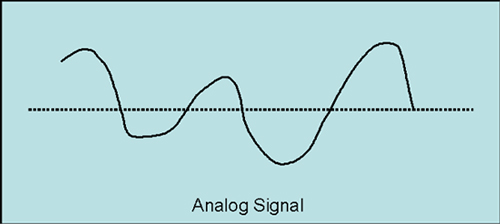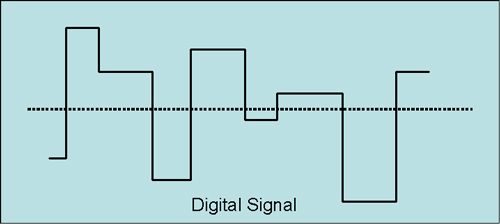
Signaling Methods and Characteristics
Background.
There are many ways that signals can be created with the goal of
networking. The following list gives the most prevalent.
Modulation refers to when the 0s and 1s that represent computer data are turned into pulses of energy. Now we want to spend a web page describing some categorizations and/or characteristics of encoded signals. We will focus on the characteristics in the following list.
Analog and Digital. You might think of listening to music on old LPs as analog replay. In contrast to this, listening to music from CDs is giving you a digital replay. Each type of signal generation and transmission has its advantages and disadvantages. While digital signaling seems to be quickly replacing almost all analog signaling, it isn't likely to ever do so completely. Analog Signals An analog signal is an electromagnetic wave that continuously changes. |

It seems that many signals
are essentially analog.
Analog signals are measured in cycles which represent a change from a relative high to a relative low and back again. When measuring cycles the following three characteristics are considered to be the most significant.
Amplitude, frequency and phase are the characteristics of a signal that are used to represent data. How this is done more specifically is beyond the scope of this course, but you might want to consult some of Forouzan's texts for more insights. Digital Signals Digital signaling is also called discrete state signaling. Digital signals change from one state to another almost instantaneously, without stopping at an in-between state. Digital signals represent discrete states over time. |

| Newer radio tuners in which you move among exact
frequency numbers to access radio stations are an example of a digital
signal. Odometers that display mileage using some sort of LED or LCD
display also are a digital representation of something that is actually
analog. Computers are digital machines in which information is represented in 0s and 1s. A binary digit is either 0 or 1, there is nothing in between. Thus, digital signaling is often the most appropriate for transmitting computer information. On the other hand, CDs contain digital representations of something that is much more likely to be considered analog information. Some people claim they can hear the subtle differences and complain about the loss of quality. The following tables contain some advantages for each type of signal. |
|
Some Advantages of Digital Signaling vs. Analog |
| generally less expensive to make the equipment |
| generally less vulnerable to errors caused by interference |
| generally offer better security |
| generally faster performance |
| generally higher reliability |
| generally less error prone |
|
Some Advantages of Analog Signaling vs. Digital |
| generally more easily multiplexed |
| generally less vulnerable to attenuation |
| Baseband and Broadband.
If the bandwidth of a particular media
is dedicated to one signal then it is called a
baseband transmission media. Ethernet on LANs is an
example of a baseband technology. On the other hand, broadband refers to dividing bandwidth into multiple channels and sending different data streams over different channels. Multiplexing is used to divide bandwidth. Cable television is an example of such a technology. DSL is another example. You should notice that companies stating that they are giving you a broadband connection is not necessarily going to give you what you want. The number advertised is often what is available cumulatively, not what you actually get on a channel. Baseband transmissions are simple relative to broadband. Baseband is usually associated with digital signals. Most computer communications are baseband, such as the signal from a computer to its monitors, printers and other peripherals are baseband. ISDN is an example of a broadband technology because multiple signals can be sent over separate channels on a single wire. Baseband signals can be bidirectional, the same media can carry a signal in either direction. Broadband channels are unidirectional, the signal flows only one direction. Thus in broadband technologies one channel is used for sending and another is used for receiving. Multiplexing. Multiplexing is a method of sending different streams of information on a link at the same time. The separate streams are then recovered at receiving end. For example, a CATV tuner built into the TV or cable box decodes the signals that enable a user to select their desired channel. Multiplexing can be accomplished through a variety of methods. Three will be very broadly discussed in the following paragraphs. They are in the following bulleted list.
Analog signals are usually multiplexed using FDM. Multiple channels are combined on a single line for transmission. Each channel is assigned a different frequency. A two way circuit requires a multiplexer/demultiplexer at each end Digital signals usually use TDM. This method combines signals for transmission on a single communications line and breaks each signal into segments with short durations. The signals are carried over the transmission media in alternating time slots. At the other end they are separated by a demultiplexer. Networks that run over fiber optic cable can make use of another type of multiplexing, DWDM. On DWDM each signal is carried on a separate wavelength of light. Different data formats, such as SONET or ATM, can simultaneously flow over the same cable. Forouzan has a much more involved and accurate discussion. Asynchronous and Synchronous Transmissions. Signals transmitting computer related data require changes in state, or modulations, to represent binary data. In order for a received signal to be correctly interpreted, the receiving device must know when the signal should be measured. In computing this timing factor is called bit synchronization. Devices can synchronize the bits by using either a synchronous or asynchronous method. Asynchronous transmissions make use of a start bit at the beginning of each message. When the receiving device receives the start bit it can synchronize its internal clock with the sender's clock. In synchronous transmissions a built in timing mechanism coordinates the clocks of the sender and receiver. Guaranteed state change synchronization relies on the clocking information to be embedded into the signal. This is the most common approach to synchronous bit synchronization. Separate clock signal synchronization requires there to be a separate channel where the clocking information is sent. Oversampling synchronization relies on having the receiving device sampling at a much faster rate than the data is being sent. It makes use of the extra measurements to synchronize the clocks. Simplex, Half Duplex, Full Duplex. The data channels over which signals are sent and received can operate in one of three ways. These methods are listed below.
Almost all TVs are receivers with no capacity to transmit signals back. They weren't developed with the capacity since there was no perceived need. When CATV first came into existence it mimicked this approach. When people wanted to start using cable lines for Internet activity they ran into some serious design problems. Some places started to use the cable for downloads and put in an additional phone line for uploads for Internet use. Others have actually installed lines with a two way infrastructure. DSL, some cable and other broadband technologies usually make use of full duplex communications. |